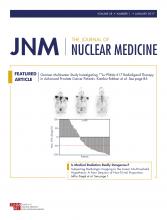Johannes Czernin
After a long period of depression and negative prospects, the field of nuclear medicine is experiencing a remarkable renaissance, with critically important developments in molecular diagnostics, therapeutics, and instrumentation. Much of this progress can be traced back to a more solid integration among the basic preclinical (biology, pharmacology, radiochemistry, physics/instrumentation), translational, and clinical sciences and applications. Above and beyond optical imaging, the use of small-animal PET imaging for disease phenotyping and therapy response evaluations is now being explored by major research groups (1). Numerous translatable imaging probes are on the verge of clinical testing or even acceptance (2,3). Clinical molecular imaging now offers a large portfolio of diagnostic, prognostic, and predictive probes (4) that measure the expression or inhibition of therapeutic targets (5) or serve as intermediate endpoint biomarkers (6) in various diseases. The value of such quantitative imaging biomarkers is also becoming apparent in drug discovery, development, and evaluations.
Imaging the expression of the prostate-specific membrane antigen is becoming a critically important part of clinical service in Europe and other parts of the world to identify sites of disease in prostate cancer patients with biochemical recurrence (7). Tracers targeting β-amyloid have refined the tools for diagnosing progressive neurodegenerative diseases (8). New fluorinated probes of myocardial perfusion will enable high-quality assessments of cardiac perfusion and function (9). These biomarkers can provide critically important information at every step of the clinical decision-making process. They will thus foster much closer interactions among nuclear medicine, cardiology, neurology, oncology, and other clinical specialties.
Novel therapeutic approaches have been established or are emerging. Effective theranostics targeting somatostatin receptors for managing neuroendocrine tumors have become the standard of care in most parts of the world (10). This approach will soon become available in the United States. Theranostic approaches targeting prostate-specific membrane antigen (11), bombesin (12), chemokine receptor type 4 (5), and others will solidify the role of nuclear medicine as a therapeutic discipline that is well integrated into the practices of oncology and medicine. Therapeutic approaches utilizing labeled antibodies or minibodies have been established or are being explored. The introduction of 223Ra (Xofigo; Bayer HealthCare) for treating bone metastases in prostate cancer patients has led to closer collaborations between urology and nuclear medicine (13). Clinical evidence of the effectiveness of prostate-specific membrane antigen–targeted theranostics is featured in the current issue of The Journal of Nuclear Medicine (JNM) (14). Thus, as a concrete example of precision medicine, nuclear medicine possesses the tools to measure and address therapeutic targets. Its large portfolio of diagnostics will lead to the development of additional theranostic pairs, resulting in closer and more relevant interdisciplinary interactions with clinical medicine and thus a much greater role for nuclear medicine in clinical practice. Advances in instrumentation have also been remarkable. In addition to PET/MRI, dedicated organ-based PET and conventional imaging systems are emerging. A true total-body PET system has been developed by Dr. Cherry's group that will enable whole-body pharmacokinetic studies that are critically important in drug development (15).
Most importantly, these advances in technologies, diagnostics, and therapeutics will have a substantial impact on the management and outcome of patients with cancer, neurologic disorders, and heart disease.
The molecular imaging and therapy community is grateful for the leadership provided by Dominique Delbeke and her team of associate editors over the last 5 years. Together with the outstanding staff, this team has maintained the leadership position of JNM among imaging journals. I am honored to have been entrusted with the editorship of JNM. My team of associate editors (Table 1) and I will make every attempt to further strengthen the position of JNM. To achieve this goal, we will add several new features to JNM. These include a series entitled “Hot Topics” (edited by Heinrich Schelbert) and a “Featured Research” series to highlight the manuscript of the month as elected by the associate editors. Representative images from this manuscript will be shown on the cover. The manuscript of the year, traditionally presented at the annual meeting of the Society of Nuclear Medicine and Molecular Imaging, will be chosen from the “Featured Research” manuscripts. We will introduce a monthly review series entitled “The State of the Art” with contributions from leading experts in molecular diagnostics and therapeutics and in related preclinical and clinical disciplines. Theranostics will be a special emphasis over the next few years (see Table of Contents). Successful series, including “Focus on Molecular Imaging” (now edited by Carolyn Anderson) and the monthly continuing education articles (edited by William Strauss and Heiko Schöder), will continue.
Team of Associate Editors
This is an exciting time for nuclear medicine, molecular imaging, and molecular therapy. The reports of the demise of our field not only are an exaggeration but are, in fact, wrong. During the next decade, nuclear medicine will experience a remarkable renaissance as diagnostic, predictive, and prognostic biomarkers become integrated with novel therapeutic approaches. After all, the dream of precision medicine is unlikely to become a reality without the ability to determine whole-body target expression and inhibition or to accurately assess treatment response early.
JNM will do its part by reporting and promoting scientific discoveries, their translation, and their implementation. Also, we will not shy away from controversies and will invite and encourage fierce discussions (16,17). JNM will thus serve as a megaphone for basic and translatable as well as clinical research discoveries as long as they are conceived with a purpose and thus have the potential to improve the outcome of our patients.
- © 2017 by the Society of Nuclear Medicine and Molecular Imaging.








